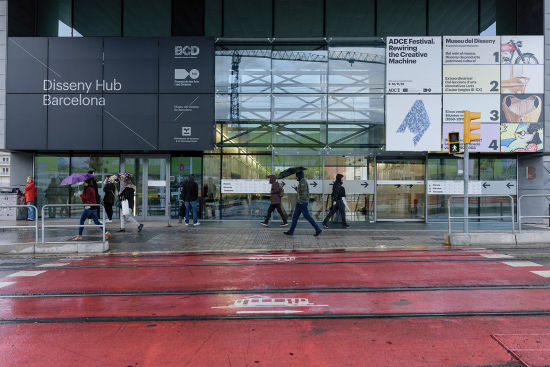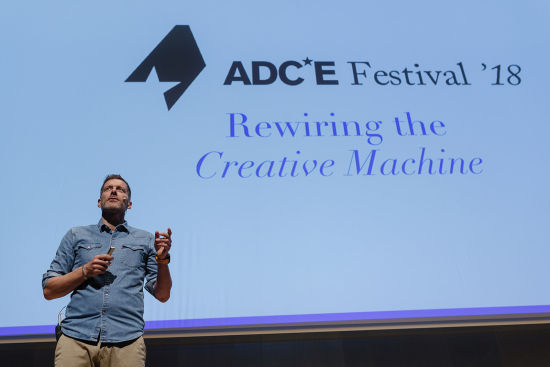
How Europe’s Smartest Agencies Are ‘Rewiring the Creative Machine’

“Those of you who were in this industry ten years ago are all survivors,” said Ami Hasan, looking out over the audience of the Barcelona Design Museum. “I have bad news for you: it’s going to get worse.” The room was packed to its sharp, geometric rafters with an international assembly of creatives and designers for the Art Directors’ Club of Europe’s annual festival and the ADCE President isn’t running away from the challenges the event hopes to provide solutions to.
His welcome speech touched on the transformation of the marketing industry that he’s seen already and the widespread disruption that he believes agencies need to prepare for when clients begin questioning the value of their marketing departments and dedicated budgets, merging them with distribution, sales, service and even product to form the discipline he calls “customer experience”.
“The big change is yet to come,” he said. “And this festival is all about trying to give you a picture of how you must change your business.”
It’s a fairly apocalyptic note to set the tone for a creative festival with, but one that certainly succeeded in putting the chips on the table ahead of the programme, titled ‘Rewiring the Creative Machine’ and curated by Happiness chief innovation officer Kris Hoet.
Kris followed Ami on stage to add rigidity to the festival’s framework, acknowledging that transformation is not all about technology and suggesting that when we cast our minds into the future we too often exaggerate the presence of technology there. He suggested that in fact the biggest shifts, although likely driven by technology, will be societal - a more distributed workforce, collaborative thinking, hybrid talent that no longer fits the boxes we currently have to put it in.

Kris Hoet
The questions that Kris posed ahead of the day’s content were: “What is the impact of the transformation going on around us? How does that impact how we come up with ideas?” He stressed that it would be a discussion, not a prescription, sharing experiences and experiments and imagining new ways of structuring creativity.
Themes laid out, Kris offered some suggestions to kick things off, listing four “superpowers” that he believes will be important in the coming creative age: curiosity, collaboration, diversity and experimentation.
“We live in surprising times,” said Wieden+Kennedy London CEO Neil Christie to open his talk ‘The Case for Chaos’. Continuing the honest tone of the day, he admitted that it’s becoming increasingly hard to make predictions about the direction things are heading in. But he did identify some trends that he considers to be threats to creativity: holding companies becoming bloated leviathans focused on delivering masses of content rather than transformative creative ideas and consultancies that want to “seek and destroy and dominate the market”. He warned that creativity is becoming “enslaved” as businesses increasingly treat it as “just another manufacturing process.”
Corporations value predictability and control, Neil explained, but these are values that threaten creative imagination. “Predictability kills the value of creativity,” he says, adding that when people ask him what Wieden+Kennedy’s “ideation process” looks like, his response is usually noncommittal. Where, he asked, is the logic in promoting a telco with a moonwalking pony, putting a ripped guy “on a horse”, or provoking people to set fire to their trainers?
Following in the spirit of sharing practical tips rather than for people to take back to their agencies rather than some huge panacea of a theory, Neil finished with eight suggestions for people to try out:

Julia Blomquist, a planner at Swedish agency Forsman & Bodenfors, joined the conversation with a perspective that was particularly relevant to the theme of ‘Rewiring the Creative Machine’ in that the agency’s structure has always been set up differently - as a ‘blob’ rather than a hierarchy, with small, multidisciplinary teams working collaboratively with clients, without layers of management between the people making the work and the people paying for it. Until recently Forsman was a relatively small anomaly in the advertising landscape, but with its recent merger with KBS the agency has expanded from around 200 to over 1,000 staff across eight offices in North America, Europe and Asia.
“Forsman is a product of Swedish society,” Julia suggested, “ where a consensus is the most important thing.” You can see this in some of the agency’s work, like the campaign where it listed the whole of Sweden as a free-to-rent property on Airbnb.
“All this might seem terribly unorganised,” she suggested. And with around 800 new co-workers joining the family, Forsman has had to “formulate the way we think, the way we are, and the way we act without putting up a framework that’s too tight.” Here came the next useful list to take home - Forsman & Bodenfors’ 11 principles on how they try to ‘Rewire the Creative Machine’:
1. We always aim for world class
2. The only boss is the task itself
3. The responsibility is yours
4. The collective is our “creative director”
5. The floor is where we share our ideas
6. Strategy and creative is one process
7. We work closely with clients
8. We embrace a “no frills” approach: if it’s too difficult its not good enough
9. We try to make the world better (not worse)
10. When it comes to recruiting we want the right people, not just the right qualifications
11. We are a human workplace
Rey Andrade of 72andSunny Amsterdam came to the day’s theme from a more human than structural perspective. The deputy executive creative director at the famously international Amsterdam agency grew up on the US-Mexico border in El Paso, Texas, giving him something of a hybrid identity (he celebrated Thanksgiving, but his family ate tamales with their turkey).
His focus was to illustrate the importance of diversity - in every dimension - to keeping the gears of the ‘creative machine’ oiled. His particular frame of reference brings interesting raw materials to the agency for them to work with, he argued, as does every kind of person the agency employs. He boiled this idea down to a single creative team at 72 - Jorgen and KC:
Jorgen is from Oslo, Norway. He speaks English and Norwegian and has lived in Oslo, Elverum, Bodo, Oxford, Miami, Los Angeles, Karlskrona and Amsterdam. He has four half-siblings, has previously worked at McDonald’s, for the Norwegian Army and as a prison guard. He’s into Italo disco and heavy metal.
His creative partner KC is from Kuala Lumpur, Malaysia. She speaks English, Malay, Mandarin and Cantonese and has lived in Kuala Lumpur, Lausanne, San Francisco, Beijing, Traviso, Boulder, Portland and Singapore. She has five siblings, has worked as a telemarketer, computer salesperson and as a farmer. She’s deep into her K-pop.
“I think this is recipe for a really good creative,” said Rey. “Every time they come to a brief they’re bringing all that stuff with them.” That’s why his agency is so proud of its international mixture.
Pip Jamieson’s vision for a rewired creative machine tied into the proliferation of multidisciplinary creatives - an ever-growing class of people with several slashes in their job descriptions. As founder of networking and recruitment platform The Dots, she extolled the virtues of the pool of freelance talent available for people to assemble using the internet, with a focus on skillsets rather than the many biases that abounded in the old recruitment landscape. Job titles are ultimately meaningless and many of them will be automated in the coming age of the robots, but creative human talents are safe and will find new homes, she reassured the audience.
An agency is a creative machine, but so is a single human brain, and that was the scale that Cancer Dojo founder Conn Bertish’s presentation worked on. Nobody would begrudge him making this one personal. Conn told the story of how he beat brain cancer - a tumor that he named Micky - through pairing his treatment with his creative skillset. Teaching himself what he later found out was called psychoneuroimmunology, Conn found ways to visualise and tell stories to himself about the treatment he was receiving, imagining his brain was made of a springy substance that would bounce back into place, or picturing the chemotherapy he was receiving fizzing through his veins and burning the cancer out.
Having harnessed these powers himself, rewiring his brain with creativity so that he could equip himself to fight his cancer, Conn decided he’d try to help others do the same through Cancer Dojo – a mobile app that empowers cancer patients to become active participants in their own healing by merging creativity, technology and medicine.
Maria Scileppi argued that the sports industry knows how to nurture and protect its talent, so why doesn’t the creative industry do the same? Why are there so many burnout stories like hers, when she woke up with a stress-induced bald patch at the age of 31? For her, this was a turning point. She promptly quit her agency job and became an artist, moving to Chicago and immersing herself in a project where she made a new friend every day. This set her off on a trajectory of fostering understanding between people, setting up 72andSunny Los Angeles’ 72U creative residency programme, setting up the perfect conditions for creativity at IDEO and then consulting for Dropbox. Like many of the day’s speakers, she suggested techniques and ideas that the audience could take back to their agencies and try, like the ‘project alignment document’ that gets everyone, quite literally, on the same page at the start of a job and the Enneagram personality test that can be helpful for building well-rounded teams and making sure people are in roles that best suit them.
The ADCE’s conference didn’t offer an all-encompassing vision of what tomorrow’s creative agency should look like. The creative leaders on stage weren’t arrogant enough to prescribe that. But every session contained practical tips and thoughts that the audience could experiment with in their own creative lives. Those experiments might not lead anywhere, but wire-by-wire, the machine will undoubtedly change in the coming years.













